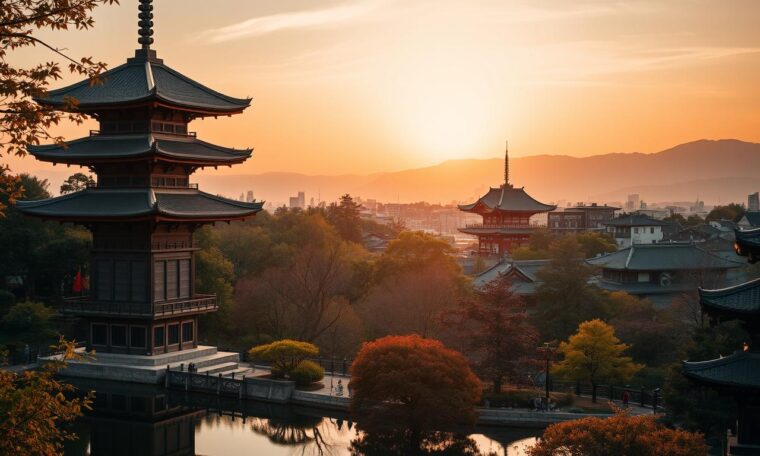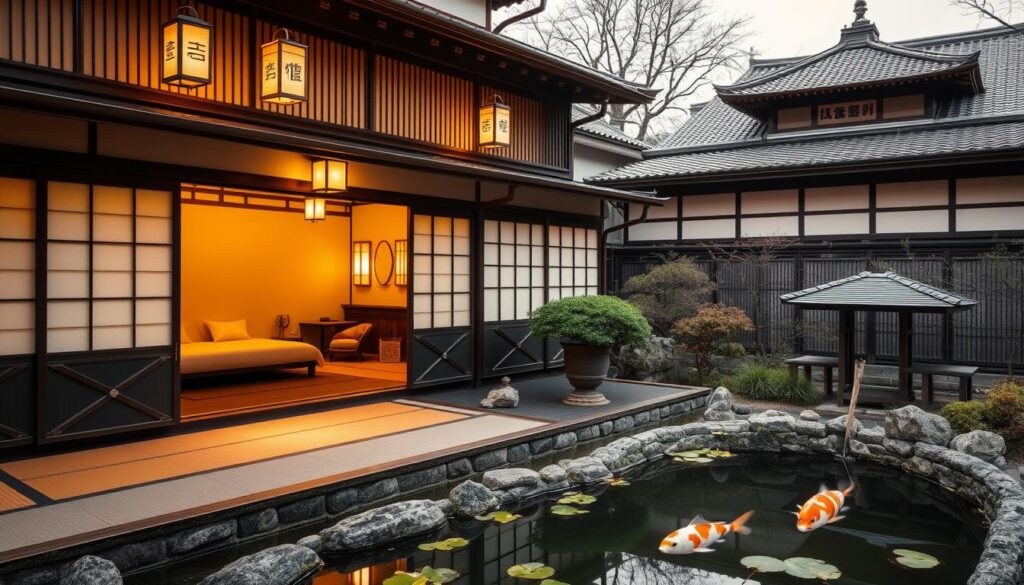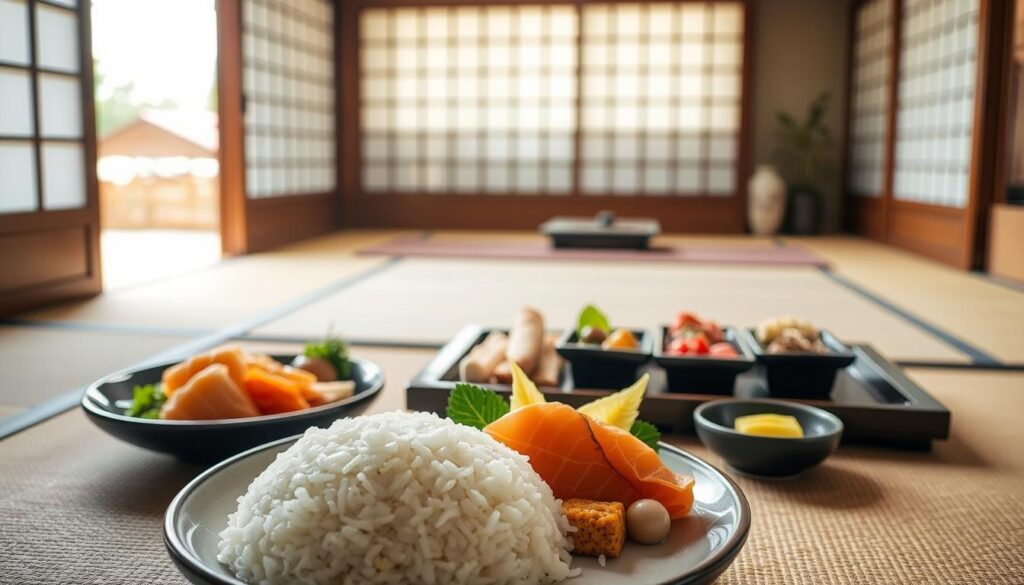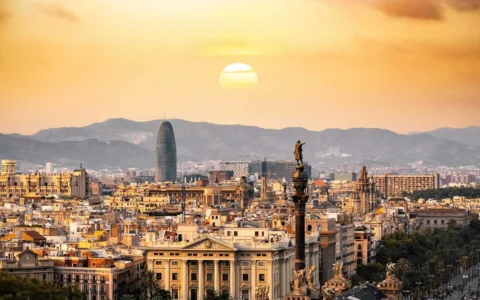
Discover the enchanting land of the rising sun, where traditional culture meets modern innovation. Kyoto, a city steeped in history, is a must-visit destination for any traveler. With its serene gardens, majestic temples, and vibrant festivals, Kyoto embodies the essence of Japanese culture.
From the bustling streets of modern cities to the tranquil countryside, Japan offers a diverse range of travel experiences. Explore the beauty of Japan’s landscapes, from mountains to coastlines, and immerse yourself in the rich cultural heritage that makes this country so unique.
Key Takeaways
- Experience the unique blend of traditional and modern culture in Kyoto.
- Discover the beauty of Japan’s diverse landscapes.
- Immerse yourself in the rich cultural heritage of Japan.
- Explore the vibrant cities and tranquil countryside.
- Visit majestic temples and serene gardens in Kyoto.
The Land of the Rising Sun: A Brief Overview
Japan, known as the Land of the Rising Sun, is a country that seamlessly blends traditional culture with modern technology. This blend is evident in its diverse landscapes and rich cultural practices.
Japan’s Geographic and Cultural Diversity
Japan is an archipelago of over 6,800 islands, with four main islands: Honshu, Hokkaido, Kyushu, and Shikoku. Its geography ranges from snowy mountains to sunny beaches, creating a variety of climates and ecosystems. This diversity supports a wide range of cultural practices and traditional ways of life.
The country’s cultural diversity is also reflected in its numerous festivals, cuisine, and traditional arts. From the cherry blossom festivals to the traditional tea ceremonies, Japan’s culture is both vibrant and serene.
Why Kyoto Stands Out Among Japanese Cities
Kyoto, once the imperial capital of Japan, is renowned for its well-preserved temples, shrines, and gardens. It stands out among Japanese cities due to its rich history and cultural heritage.
Historical Significance as the Former Imperial Capital
As the former imperial capital, Kyoto was the center of Japanese politics and culture for over 1,000 years. It is home to numerous UNESCO World Heritage sites, including the iconic Kinkaku-ji temple.
| City | Historical Significance | Cultural Landmarks |
|---|---|---|
| Kyoto | Former imperial capital | Kinkaku-ji, Fushimi Inari |
| Tokyo | Current capital | Shibuya Crossing, Meiji Shrine |
| Osaka | Commercial center | Osaka Castle, Dotonbori |
Planning Your Journey to Kyoto, Japan
To experience the best of Kyoto, it’s essential to plan your trip meticulously, taking into account the time of year, travel documents, and budget. This careful planning will ensure that your visit is both enjoyable and stress-free.
Best Times to Visit Kyoto
Kyoto is a year-round destination, but the best times to visit are during spring (March to May) and autumn (September to November). These periods offer mild weather and stunning natural beauty, with cherry blossoms in the spring and vibrant autumn foliage.
Visa Requirements for American Travelers
American citizens can visit Japan for up to 90 days without a visa, provided they meet certain requirements, such as having a valid passport and proof of onward travel. It’s always a good idea to check the latest visa requirements before your trip.
Budgeting for Your Japanese Adventure
Budgeting is a crucial aspect of trip planning. Kyoto can be expensive, but with some planning, you can manage costs. Consider budgeting for accommodations, food, transportation, and attractions.
Currency Exchange and Payment Methods
Japan is predominantly a cash-based society, although credit card acceptance is increasing. You’ll need to exchange your currency for Japanese yen or use an ATM to withdraw cash. Many places also accept international credit cards, especially in tourist areas.
Getting to and Around Japan’s Ancient Capital
Kyoto, the heart of Japan’s cultural identity, is easily accessible by air and land. For international travelers, the nearest major airport is Kansai International Airport (KIX), which is connected to Kyoto by efficient rail services.
International Travel to Japan
Most international flights arrive at either Kansai International Airport or Tokyo’s Narita and Haneda airports. From these airports, travelers can take domestic flights, buses, or trains to reach Kyoto. The Japan Rail Pass is an economical option for those planning to travel extensively within Japan.
Navigating Japan’s Efficient Rail System
Japan’s rail network is renowned for its punctuality and efficiency. The Shinkansen (bullet train) connects major cities, including Kyoto. Understanding the different types of trains and passes available is crucial for a smooth journey.
Understanding the Japan Rail Pass
The Japan Rail Pass offers unlimited travel on JR trains, buses, and ferries for a fixed period. It’s an ideal option for travelers planning to explore multiple destinations in Japan. The pass can be purchased online before your trip or at major JR train stations.
Local Transportation Options in Kyoto
Kyoto has a comprehensive network of buses and subways, making it easy to get around the city. The Kyoto City Bus and Kyoto Subway are convenient options, with English signage and announcements. For a more traditional experience, Kyoto’s streets are also navigable on foot or by bicycle.
Where to Stay in Kyoto
With its rich cultural heritage, Kyoto provides an array of lodging options, from traditional ryokans to modern hotels. Choosing the right accommodation is crucial for a memorable Kyoto experience.
Traditional Ryokan Experience
A traditional ryokan offers a unique glimpse into Japan’s cultural past. These establishments are known for their tatami-matted rooms, sliding doors, and communal baths. Staying at a ryokan like Hiiragiya Ryokan allows you to experience Kyoto’s heritage firsthand.
Modern Hotel Accommodations
For those preferring modern amenities, Kyoto’s hotels offer comfort and convenience. Many hotels, such as the The Ritz-Carlton, Kyoto, provide excellent service, stylish rooms, and often, a blend of traditional and contemporary design.
Budget-Friendly Options for Extended Stays
Travelers on a budget can find affordable accommodations in Kyoto, including guesthouses and hostels. These options are ideal for extended stays, offering a chance to experience local life. Neighborhoods like Kawaramachi and Gion are popular among visitors.
Neighborhood Guide for First-Time Visitors
For first-time visitors, understanding Kyoto’s neighborhoods is key to choosing the right accommodation. The Kawaramachi area is known for its shopping and dining, while Gion
By considering these options, travelers can select accommodations that best fit their interests and budget, ensuring a fulfilling Kyoto experience.
Kyoto’s Historic Temples and Shrines
Kyoto’s landscape is dotted with ancient temples and shrines, each telling a story of Japan’s spiritual past. These sacred sites are not only significant culturally and historically but also offer breathtaking beauty and tranquility amidst the bustling city.
Kinkaku-ji: The Golden Pavilion
Kinkaku-ji, or the Golden Pavilion, is one of Kyoto’s most iconic landmarks. This Zen temple is famous for its stunning garden and the pavilion itself, which is covered in gold leaf. The reflection of the pavilion in the surrounding pond creates a serene and picturesque scene.
Fushimi Inari Taisha and Its Thousand Torii Gates
Fushimi Inari Taisha is renowned for its thousands of vermilion torii gates that form a tunnel up the mountain. This shrine is dedicated to Inari, the Shinto god of rice, and is a significant site for those interested in Shintoism. Hiking up the mountain through the torii gates offers a unique and spiritual experience.
Kiyomizu-dera Temple and Its Spectacular Views
Kiyomizu-dera Temple, a UNESCO World Heritage site, is perched on a hill, offering panoramic views of Kyoto. The temple is famous for its wooden stage protruding over the valley below, providing a dramatic view. It’s a place of great spiritual significance and a must-visit during any trip to Kyoto.
Etiquette for Visiting Sacred Sites in Japan
When visiting temples and shrines in Kyoto, it’s essential to respect local customs and etiquette. This includes dressing modestly, removing shoes when required, and being mindful of rituals and ceremonies. Understanding and adhering to these practices enhances the experience and shows respect for the cultural heritage.
| Temple/Shrine | Significance | Must-see Feature |
|---|---|---|
| Kinkaku-ji | Zen temple, cultural icon | Golden Pavilion |
| Fushimi Inari Taisha | Shinto shrine, Inari worship | Thousand Torii Gates |
| Kiyomizu-dera | Buddhist temple, panoramic views | Wooden Stage |
Visiting these historic temples and shrines is a journey through Kyoto’s rich spiritual and cultural heritage. Each site offers a unique glimpse into Japan’s history and traditions, making Kyoto a fascinating destination for travelers worldwide.
“The very heart of Japan lies in the beauty of its temples and shrines, where the spiritual and the natural blend in perfect harmony.”
Exploring Japan’s Most Beautiful Natural Landscapes in Kyoto
Beyond its temples and shrines, Kyoto boasts some of Japan’s most breathtaking natural landscapes. The city’s diverse geography, from bamboo forests to mountain gardens, offers a serene escape from the urban bustle.
Arashiyama Bamboo Grove
One of Kyoto’s most iconic natural attractions is the Arashiyama Bamboo Grove. This serene area is characterized by towering bamboo stalks that sway gently in the wind, creating a tranquil atmosphere. Visitors can stroll along the walking paths, take in the unique sounds, and enjoy the picturesque scenery.
Cherry Blossom Viewing Spots
Kyoto is renowned for its cherry blossom viewing spots. Popular locations include Maruyama Park and Philosopher’s Path, where hundreds of cherry trees bloom in the spring. The soft pink blossoms create a stunning visual spectacle, attracting visitors from around the world.
Autumn Foliage in Kyoto’s Gardens
As the seasons change, Kyoto’s gardens transform into vibrant displays of autumn foliage. The city’s many parks and gardens, such as Koko-an and Shoren-in, are ablaze with color as the leaves turn. This natural phenomenon is a major draw for tourists and locals alike.
Seasonal Natural Phenomena Worth Planning Around
Kyoto’s natural beauty is not limited to a single season. Each time of year brings its own unique attractions:
- Spring: Cherry blossoms
- Summer: Lush greenery and water features
- Autumn: Vibrant foliage
- Winter: Serene landscapes and illuminated gardens
| Season | Natural Phenomena | Best Locations |
|---|---|---|
| Spring | Cherry Blossoms | Maruyama Park, Philosopher’s Path |
| Autumn | Foliage | Koko-an, Shoren-in |
| Year-round | Bamboo Grove | Arashiyama |
By planning your visit around these seasonal natural phenomena, you can experience the full breadth of Kyoto’s natural beauty.
Immersing Yourself in Japanese Cultural Experiences
Kyoto, the cultural heart of Japan, offers a plethora of experiences that allow visitors to deeply immerse themselves in traditional Japanese culture. From traditional tea ceremonies to the elegant geisha culture, Kyoto is a city that proudly preserves its heritage while welcoming visitors to participate in its rich cultural tapestry.
Traditional Tea Ceremonies
A visit to Kyoto is not complete without experiencing a traditional Japanese tea ceremony. These ceremonies, rooted in Zen Buddhism, are not just about drinking tea; they are a highly ritualized ceremony in which green tea is prepared and served to guests in a specially designed room. The ceremony embodies the principles of harmony, respect, purity, and tranquility.
Urasenke, a renowned tea ceremony school in Kyoto, offers visitors the opportunity to participate in these traditional ceremonies, providing a unique insight into Japanese culture.
Geisha Culture in Gion District
Kyoto’s Gion District is famous for its geisha culture, a traditional form of Japanese entertainment where highly trained artists perform music, dance, and poetry. Visitors can stroll through the district’s historic streets, potentially catching a glimpse of geishas and maikos (apprentice geishas) on their way to engagements.
Participating in Local Festivals
Kyoto hosts numerous festivals throughout the year, each offering a unique cultural experience. The Gion Matsuri, one of Kyoto’s most famous festivals, takes place in July and features elaborate floats and traditional performances.
Hands-on Cultural Workshops for Tourists
For a more interactive cultural experience, Kyoto offers various hands-on workshops where visitors can learn traditional crafts, such as calligraphy, woodblock printing, and pottery. These workshops provide a fun and engaging way to understand the skill and precision involved in these traditional arts.
Participating in these cultural experiences not only enriches your travel experience but also provides a deeper appreciation for Kyoto’s and Japan’s cultural heritage.
Culinary Delights of Japan: Kyoto’s Food Scene
From traditional kaiseki cuisine to street food, Kyoto’s dining scene is a gastronomic journey like no other. The city’s culinary delights are deeply rooted in its cultural heritage, offering a unique blend of flavors and dining experiences.
Kyoto’s Unique Kaiseki Cuisine
Kaiseki is a multi-course Japanese dinner that emphasizes local, seasonal ingredients and simple preparation methods. It’s an art form that combines taste, texture, and presentation. Gion Nanba, a renowned restaurant in Kyoto, is known for its exquisite kaiseki experience. Visitors can enjoy this traditional meal in a serene and elegant setting.

Street Food Must-Tries
Kyoto’s street food scene is vibrant and diverse, offering a range of delicious options. Some must-try street foods include yudofu (boiled tofu) and ningyo-yaki (small cakes filled with sweet bean paste). These dishes are not only tasty but also provide a glimpse into Kyoto’s culinary traditions.
Navigating Dining Etiquette in Japan
Understanding dining etiquette is crucial when enjoying meals in Kyoto. For instance, it’s customary to wait for the host to start eating before you begin. Additionally, it’s considered polite to try a little of everything served. For those with dietary restrictions, it’s a good idea to inform your server or restaurant in advance.
Vegetarian and Dietary Restriction Options
Kyoto offers a variety of vegetarian and dietary restriction options. Many restaurants cater to these needs, especially during religious festivals when vegetarian cuisine is more prevalent. Saryo Tsujiri is a great spot for matcha and traditional sweets, offering some vegetarian options.
| Dining Option | Description | Price Range |
|---|---|---|
| Kaiseki | Multi-course meal emphasizing local ingredients | $50-$100 |
| Street Food | Variety of snacks like yudofu and ningyo-yaki | $5-$10 |
| Vegetarian | Options available, especially during festivals | $10-$30 |
Day Trips from Kyoto to Explore More of Japan
Beyond Kyoto’s temples and gardens, Japan’s rich cultural heritage and natural beauty await discovery on day trips. The city’s central location makes it an ideal base for exploring the surrounding region.
Nara and Its Friendly Deer Park
Nara is a historic city located about an hour from Kyoto by train. It’s famous for its friendly deer that roam the Nara Park, a large public park that’s also home to numerous temples and shrines, including the Todai-ji Temple, which houses the largest bronze Buddha statue in the world.
Osaka’s Modern Cityscape and Street Food
Osaka is another popular day trip destination, known for its modern cityscape, entertainment districts, and delicious street food. Visitors can enjoy the Universal Studios Japan, explore the Osaka Castle, or sample local delicacies like takoyaki and okonomiyaki.
Hiking in the Peaceful Mountains of Kurama
For those looking to escape the urban bustle, Kurama offers a serene hiking experience. Located about 45 minutes from Kyoto by train, Kurama is nestled in the mountains and features hiking trails, hot springs, and the Kurama Temple. It’s a perfect day trip for nature lovers.
Transportation Tips for Day Excursions
Getting to these destinations is convenient thanks to Japan’s efficient rail system. Here are some tips:
- Use a Japan Rail Pass for unlimited travel on JR trains, buses, and ferries.
- Purchase IC cards like Suica or Pasmo for easy travel on local trains and subways.
- Check train schedules in advance using apps like Hyperdia or Google Maps.
Conclusion: The Timeless Appeal of Kyoto, Japan
Kyoto, a city that seamlessly blends tradition with modernity, is a travel destination like no other. With its rich history, vibrant culture, and breathtaking natural landscapes, Kyoto has something to offer every kind of traveler.
From the serene gardens and majestic temples to the bustling streets of Gion and the tranquil Arashiyama bamboo forest, Kyoto’s diverse attractions are sure to captivate visitors. The city’s unique cultural experiences, such as traditional tea ceremonies and geisha performances, provide a glimpse into Japan’s fascinating heritage.
As you plan your travel to Kyoto, you’ll discover that this ancient capital is a city that will leave you with unforgettable memories. Whether you’re drawn to its historic landmarks, natural beauty, or cultural experiences, Kyoto is a destination that will inspire and enchant you. In conclusion, Kyoto is a must-visit destination for anyone looking to explore the best of Japan.

